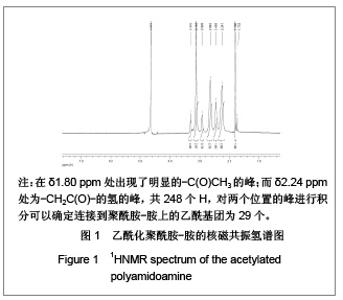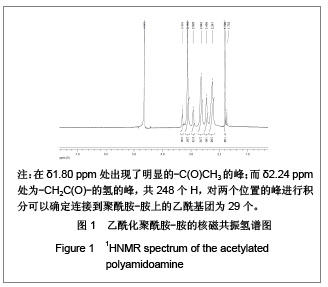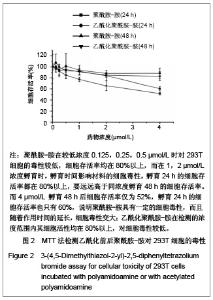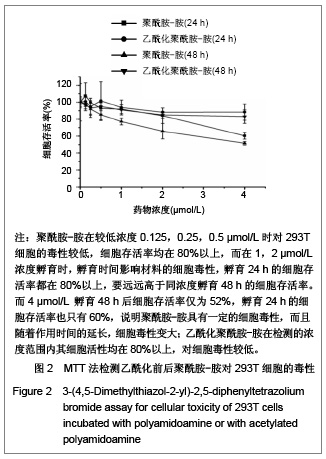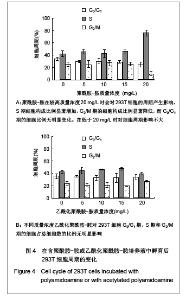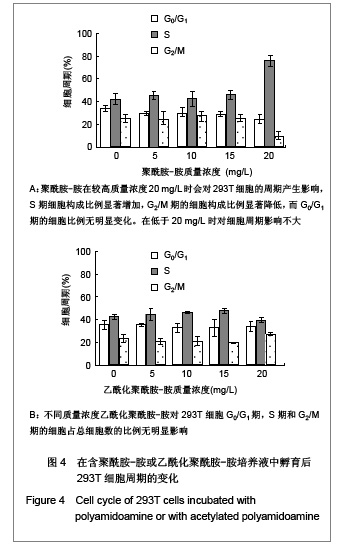Chinese Journal of Tissue Engineering Research ›› 2013, Vol. 17 ›› Issue (12): 2191-2196.doi: 10.3969/j.issn.2095-4344.2013.12.015
Previous Articles Next Articles
Acetylation attenuates polyamidoamine cytotoxicity
Acetylation attenuates polyamidoamine cytotoxicity
- Tianjin Key Laboratory of Molecular Nuclear Medicine, Institute of Radiation Medicine, Chinese Academy of Medical Science & Peking Union Medical College, Tianjin 300192, China
-
Received:2012-07-14Revised:2012-08-14Online:2013-03-19Published:2013-03-19 -
Contact:Liu Jin-jian, Tianjin Key Laboratory of Molecular Nuclear Medicine, Institute of Radiation Medicine, Chinese Academy of Medical Science & Peking Union Medical College, Tianjin 300192, China liujinjian2002@163.com -
About author:Liu Jian-feng☆, Doctor, Tianjin Key Laboratory of Molecular Nuclear Medicine, Institute of Radiation Medicine, Chinese Academy of Medical Science & Peking Union Medical College, Tianjin 300192, China lewis78@163.com
CLC Number:
Cite this article
Acetylation attenuates polyamidoamine cytotoxicity. Acetylation attenuates polyamidoamine cytotoxicity[J]. Chinese Journal of Tissue Engineering Research, 2013, 17(12): 2191-2196.
share this article
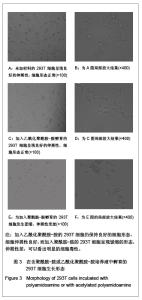
由图2可以看出聚酰胺-胺在较低浓度0.125,0.25,0.5 μmol/L时对293T细胞的毒性较低,细胞存活率均在80%以上,而在1,2 μmol/L浓度孵育时,孵育时间影响材料的细胞毒性,孵育24 h的细胞存活率都在80%以上,要远远高于同浓度孵育48 h的细胞存活率。而 4 μmol/L 孵育48 h后细胞存活率仅为52%,孵育24 h的细胞存活率也只有60%,说明聚酰胺-胺具有一定的细胞毒性,而且随着作用时间的延长,细胞毒性变大,这与文献[18-19]报道的结果一致;而乙酰化聚酰胺-胺在检测浓度范围内其细胞活性均在80%以上,不论是孵育24 h还是48 h都展示出了较低的细胞毒性。经统计学分析,在4 μmol/L浓度条件下,24,48 h组间比较差异有非常显著性意义(P < 0.01),说明乙酰化可以显著降低聚酰胺-胺的细胞毒性。 2.3 乙酰化前后聚酰胺-胺孵育细胞的形态观察 293T细胞在正常生长条件下具有良好的伸展性,以培养液为阴性对照,观察聚酰胺-胺及乙酰化聚酰胺-胺孵育的293T细胞,结果见图3,从图中可以看出未加任何材料的细胞及加入乙酰化聚酰胺-胺培养的细胞均呈现出良好的伸展性,细胞形态正常,而加入聚酰胺-胺的细胞发生团缩,伸展性变差。"
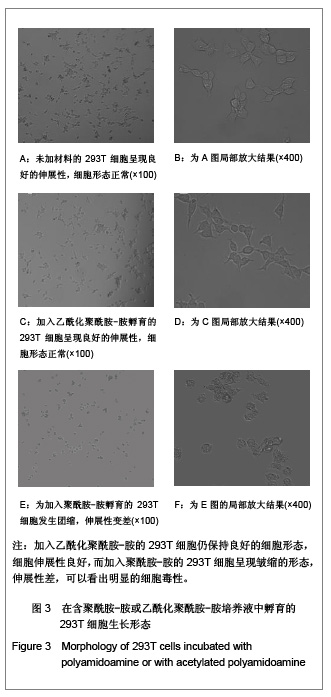
| [1] Qu G,Wu X,Yin L,et al. N-octyl-O-sulfate chitosan-modified liposomes for delivery of docetaxel: preparation, characterization, and pharmacokinetics. Biomed Pharmacother.2012;66(1):46-51.[2] Cosco D,Paolino D,Cilurzo F,et al.Gemcitabine and tamoxifen-loaded liposomes as multidrug carriers for the treatment of breastcancer diseases. Int J Pharm.2012; 422 (1-2):229-237.[3] Nakagawa Y,Takayama K,Ueda H,et al.Preparation of bovine serum albumin nanospheres as drug targeting carriers. Drug Des Deliv.1987;2(2): 99-107.[4] Sonaje K,Lin KJ,Wey SP,et al.Biodistribution, pharmacodynamics and pharmacokinetics of insulin analogues in a rat model: Oral delivery using pH-responsive nanoparticles vs. subcutaneous injection. Biomaterials. 2010; 31(26): 6849-6858. [5] Sudheesh MS,Vyas SP,Kohli DV.Nanoparticle-based immunopotentiation via tetanus toxoid-loaded gelatin and aminatedgelatin nanoparticles. Drug Deliv. 2011;18(5): 320-330.[6] Hoffmann S,Vystr?ilová L,Ulbrich K,et al.Dual fluorescent HPMA copolymers for passive tumor targeting with pH-sensitive drug release: synthesis and characterization of distribution and tumor accumulation in mice by noninvasive multispectral optical imaging.Biomacromolecules. 2012;13(3): 652-663.[7] Yoncheva K,Calleja P,Agüeros M,et al.Stabilized micelles as delivery vehicles for paclitaxel.Int J Pharm.2012;436(1-2): 258-264.[8] Yuan W,Liu Z.Controlled-release and preserved bioactivity of proteins from (self-assembled) core-shell double-walled microspheres.Int J Nanomedicine. 2012;7:257-270.[9] Puvanakrishnan P,Park J,Chatterjee D,et al.In vivo tumor targeting of gold nanoparticles: effect of particle type and dosing strategy.Int J Nanomedicine. 2012;7:1251-1258.[10] Wahajuddin, Arora S. Superparamagnetic iron oxide nanoparticles: magnetic nanoplatforms as drug carriers. Int J Nanomedicine.2012;7:3445-3471.[11] Fabbro C,Ali-Boucetta H,Da Ros T,et al. Targeting carbon nanotubes against cancer.Chem Commun (Camb).2012; 48(33): 3911-3926.[12] Tomalia D,Baker H,Dewald J,et al.A New Class of Polymers: Starburst-Dendritic Macromolecules. Polymer J.1985;17: 117-132.[13] Paleos CM,Tsiourvas D,Sideratou Z,et al.Drug delivery using multifunctional dendrimers and hyperbranched polymers. Expert Opin Drug Deliv. 2010;7(12):1387-1398.[14] Yao W,Sun K,Mu H,et al.Preparation and characterization of puerarin–dendrimer complexes as an ocular drug delivery system. Drug Dev Ind Pharm.2010;36(9): 1027-1035.[15] Rodrigo AC,Rivilla I,Pérez-Martínez FC,et al. Efficient, non-toxic hybrid PPV-PAMAM dendrimer as a gene carrier for neuronal cells. Biomacromolecules. 2011;12(4): 1205-1213 .[16] Kumar A,Yellepeddi VK,Davies GE,et al.Enhanced gene transfection efficiency by polyamidoamine (PAMAM) dendrimers modified with ornithine residues.Int J Pharm. 2010;392(1-2): 294-303.[17] Roberts JC,Bhalgat MK,Zera RT.Preliminary biological evaluation of polyamidoamine (PAMAM) Starburst dendrimers.J Biomed Mater Res.1996;30(1): 53-65.[18] Malik N,Wiwattanapatapee R,Klopsch R,et al.Dendrimers: relationship between structure and biocompatibility in vitro, and preliminary studies on the biodistribution of 125I-labelled polyamidoamine dendrimers in vivo. J Control Release.2000; 65(1-2): 133-148.[19] Hong S,Bielinska AU,Mecke A,et al.Interaction of poly(amidoamine) dendrimers with supported lipid bilayers and cells: hole formation and the relation to transport. Bioconjug Chem. 2004;15(4): 774-782.[20] Liu JF,Liu JJ,Chu LP,et al.Novel peptide-dendrimer conjugates as drug carrier for targeting nonsmall cell lung cancer. Int J Nanomed. 2011;6: 59-69.[21] Singh P,Gupta U,Asthana A,et al.Folate and folate-PEG-PAMAM dendrimers: synthesis, characterization, and targeted anticancer drug delivery potential in tumor bearing mice. Bioconjug Chem.2008;19(11): 2239-2252.[22] Zheng N,Dai W,Du W,et al. A novel lanreotide-encoded micelle system targets paclitaxel to the tumors with overexpression of somatostatin receptors. Mol Pharm. 2012;9(5): 1175-1188.[23] Wang J,Sui M,Fan W.Nanoparticles for tumor targeted therapies and their pharmacokinetics. Curr Drug Metab.2010; 11(2): 129-141.[24] Ke W,Zhao Y,Huang R,et al.Enhanced oral bioavailability of doxorubicin in a dendrimer drug delivery system. J Pharm Sci. 2008;97(6): 2208-2216.[25] Milhem OM,Myles C,McKeown NB,et al.Polyamidoamine Starburst dendrimers as solubility enhancers. Int J Pharm. 2000;197(1-2): 239-241.[26] Kolhe P,Misra E,Kannan RM,et al. Drug complexation, in vitro release and cellular entry of dendrimers and hyperbranched polymers. Int J Pharm. 2003;259(1-2): 143-160.[27] Zhu S,Hong M,Zhang L,et al.PEGylated PAMAM dendrimer-doxorubicin conjugates: in vitro evaluation and in vivo tumor accumulation. Pharm Res. 2010; 27(1): 161-174.[28] Wiwattanapatapee R,Lomlim L,Saramunee K.Dendrimers conjugates for colonic delivery of 5-aminosalicylic acid.J Control Release.2003;88(1): 1-9. |
| [1] | Wang Shiqi, Zhang Jinsheng. Effects of Chinese medicine on proliferation, differentiation and aging of bone marrow mesenchymal stem cells regulating ischemia-hypoxia microenvironment [J]. Chinese Journal of Tissue Engineering Research, 2021, 25(7): 1129-1134. |
| [2] | Li Cai, Zhao Ting, Tan Ge, Zheng Yulin, Zhang Ruonan, Wu Yan, Tang Junming. Platelet-derived growth factor-BB promotes proliferation, differentiation and migration of skeletal muscle myoblast [J]. Chinese Journal of Tissue Engineering Research, 2021, 25(7): 1050-1055. |
| [3] | Liu Cong, Liu Su. Molecular mechanism of miR-17-5p regulation of hypoxia inducible factor-1α mediated adipocyte differentiation and angiogenesis [J]. Chinese Journal of Tissue Engineering Research, 2021, 25(7): 1069-1074. |
| [4] | Jiang Xin, Qiao Liangwei, Sun Dong, Li Ming, Fang Jun, Qu Qingshan. Expression of long chain non-coding RNA PGM5-AS1 in serum of renal transplant patients and its regulation of human glomerular endothelial cells [J]. Chinese Journal of Tissue Engineering Research, 2021, 25(5): 741-745. |
| [5] | Ma Zetao, Zeng Hui, Wang Deli, Weng Jian, Feng Song. MicroRNA-138-5p regulates chondrocyte proliferation and autophagy [J]. Chinese Journal of Tissue Engineering Research, 2021, 25(5): 674-678. |
| [6] | Wang Yujiao, Liu Dan, Sun Song, Sun Yong. Biphasic calcium phosphate loaded with advanced platelet rich fibrin can promote the activity of rabbit bone marrow mesenchymal stem cells [J]. Chinese Journal of Tissue Engineering Research, 2021, 25(4): 504-509. |
| [7] | Zhou Jihui, Yao Meng, Wang Yansong, Li Xinzhi, Zhou You, Huang Wei, Chen Wenyao. Influence of novel nanoscaffolds on biological behaviors of neural stem cells and the related gene expression [J]. Chinese Journal of Tissue Engineering Research, 2021, 25(4): 532-536. |
| [8] | Li Li, Ma Li. Immobilization of lactase on magnetic chitosan microspheres and its effect on enzymatic properties [J]. Chinese Journal of Tissue Engineering Research, 2021, 25(4): 576-581. |
| [9] | Zhou Wu, Wang Binping, Wang Yawen, Cheng Yanan, Huang Xieshan. Transforming growth factor beta combined with bone morphogenetic protein-2 induces the proliferation and differentiation of mouse MC3T3-E1 cells [J]. Chinese Journal of Tissue Engineering Research, 2021, 25(23): 3630-3635. |
| [10] | Liu Keke, Duan Xin, Ma Xiangrui, Zhang Yuntao. Effect of cinnamaldehyde on osteoblasts in high glucose environment with the electrospinning membrane as a carrier [J]. Chinese Journal of Tissue Engineering Research, 2021, 25(22): 3500-3504. |
| [11] | He Lin, Wu Xi, He Song, Yang Sen. Hydrophilicity and cell adhesion of hydroxyapatite bioceramics after the coating of polydopamine [J]. Chinese Journal of Tissue Engineering Research, 2021, 25(22): 3540-3544. |
| [12] | Zhou Anqi, Tang Yufei, Wu Bingfeng, Xiang Lin. Designing of periosteum tissue engineering: combination of generality and individuality [J]. Chinese Journal of Tissue Engineering Research, 2021, 25(22): 3551-3557. |
| [13] | Lang Limin, He Sheng, Jiang Zengyu, Hu Yiyi, Zhang Zhixing, Liang Minqian. Application progress of conductive composite materials in the field of tissue engineering treatment of myocardial infarction [J]. Chinese Journal of Tissue Engineering Research, 2021, 25(22): 3584-3590. |
| [14] | Song Shilei, Chen Yueping, Zhang Xiaoyun, Li Shibin, Lai Yu, Zhou Yi. Potential molecular mechanism of Wuling powder in treating osteoarthritis based on network pharmacology and molecular docking [J]. Chinese Journal of Tissue Engineering Research, 2021, 25(20): 3185-3193. |
| [15] | Yu Chengshuai, Du Gang, Pang Shenning, Lao Shan. Chemerin, a pro-inflammatory adipokine, regulates chondrocyte proliferation and metabolism by increasing production of nitric oxide [J]. Chinese Journal of Tissue Engineering Research, 2021, 25(2): 258-263. |
| Viewed | ||||||
|
Full text |
|
|||||
|
Abstract |
|
|||||
